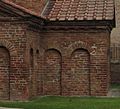Pilaster strips

The pilaster (of French. Lisière "hem", "edge", "edge"), even wall aperture , is in the construction a narrow, and slightly protruding vertical reinforcement of the wall. The horizontal design element corresponding to the pilaster is called the cornice .
Other word forms: Lesine, Laschene.
function
Pilaster strips are used in architecture to visually structure a facade or other wall surface, but - in contrast to pilasters - without a base or capital . They serve as pseudo-architecture not only to decorate smooth walls, but also as corner pilaster strips to emphasize the edges of the building - at technically relevant points, however, the effect of reinforcing the supporting structure is definitely added: the Romanesque pilaster strip can be used as the original form of the Gothic one the buttress pulled out of the building .
use
Pilaster strips were used in different epochs, including in Roman and subsequently in Byzantine architecture . This style, which was widespread in northern Italy (especially in Ravenna ), was adopted by the Germanic Lombards who settled there , so that pilaster strips connected to one another by arched friezes became almost stylistic features of Lombard architecture . Lombard builders were famous for their craftsmanship and sought after abroad, thus promoting the spread of this style.
North of the Alps, these design elements can be found very early on in the collegiate churches of St. Cyriakus in Gernrode (before 1000) or the nearby St. Servatius in Quedlinburg (997-1021). The use of pilaster strips on the Speyer Cathedral (1030–1106) had a great influence , which inspired many architects to imitate them. You can find them in many Romanesque churches.
Since the Renaissance , pilasters have completely displaced pilaster strips - although formally oriented architects such as Palladio and the builders of the classicist Baroque use very reduced, pilaster-like elements. But it then revives in historicism ( neo-Gothic ) and can be found consistently in the functional architecture of high industrialism , especially in brick architecture . The plastered facades of historicism also use the pilaster strips as a plaster structure, in particular as a corner pilaster strip to surround the facade at the edge of the building. In grooved form, it becomes a corner cuboid there .
Since brutalism , the pilaster strip has been used as a visible supporting element of the skeleton structure in concrete - not as a dummy support, but as a functional supporting element .
gallery
Pilaster strips and arched frieze at the mausoleum of Galla Placidia in Ravenna (c. 430 AD)
Pilaster strips on the stair tower of the collegiate church Gernrode (before 1000)
Pilaster strips at the Maria Laach Abbey Church (1156)
- Modern and post-modern
Robin Hood Gardens , London - Lisenen-shaped formation of the supporting masonry in the style of the prefabricated building
Pilaster strips at the Chilehaus , Hamburg
Other uses of the word
In cabinet making, a pilaster strip is a raised vertical bar that frames recessed fields, especially on one edge of the piece of furniture. Examples can be found in the Frankfurt cabinet and in piano construction. In window construction, a pilaster strip is a vertical component that divides the window.
literature
- Wilfried Koch: Architectural style . 32nd edition, Prestel, Munich 2005, ISBN 978-3-7913-4997-8 , p. 465.






